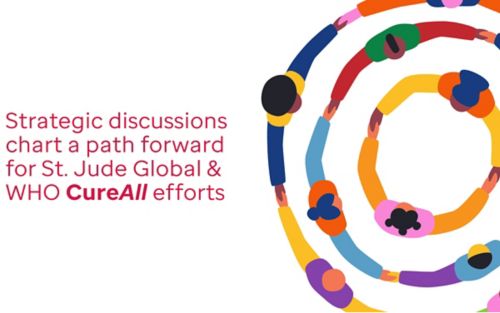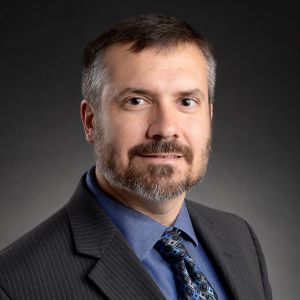St. Jude Family of Websites
Explore our cutting edge research, world-class patient care, career opportunities and more.
St. Jude Children's Research Hospital Home

- Fundraising
St. Jude Family of Websites
Explore our cutting edge research, world-class patient care, career opportunities and more.
St. Jude Children's Research Hospital Home

- Fundraising
Strategic discussions chart a path forward for St. Jude Global & WHO CureAll efforts

In a meeting held at St. Jude representatives from around the world discussed their work raising the survival rate for childhood cancer on a global scale.
The Global Initiative for Childhood Cancer (GICC) was launched in September 2018 to bring together stakeholders from around the world with the shared goal of increasing the childhood cancer survival rate to 60% by 2030 and reducing suffering for all. Almost five years later, this work continues through the CureAll approach in nearly 70 countries across the six World Health Organization (WHO) regions.
St. Jude serves as the lead implementation partner for the GICC, jointly conceptualizing the effort with WHO and providing ongoing technical and financial support for staff and activities. Support from St. Jude includes providing specialized tools and packages for implementation and monitoring, funding and coordination of workshops and projects in focus countries and facilitating ongoing discussions among national and international stakeholders.
As part of this work, St. Jude Global, as the WHO Collaborating Centre for Childhood Cancer, recently welcomed Ministry, hospital and partner representatives from six countries actively engaged in the GICC, along with representatives from WHO Country and Regional Offices and Headquarters, to Memphis for strategic discussions.
“Five years ago, we started the Global Initiative for Childhood Cancer, which is a good umbrella and meeting place for all the stakeholders, policymakers, authorities, providers, parents, NGOs, academia — everyone who focuses on this shared dream,” said Carlos Rodriguez-Galindo, MD, Executive Vice President, St. Jude Global director and St. Jude Department of Global Pediatric Medicine chair.
“Five years — that was just the beginning of this long journey,” he continued. “This opportunity to bring together our friends from WHO and champions from other countries is invaluable to ensure we continue down this path together to strengthen the health systems for our children to receive the best outcomes.”
Voices from around the world share their CureAll progress
The morning session focused on supporting and strengthening the CureAll implementation at a country level. Representatives from six engaged countries — spanning WHO regions — shared presentations about their respective progress. This included Ecuador, Jordan, Mongolia, Nepal, Uzbekistan and Zambia.
The afternoon session focused on the broader progress from the perspective of WHO regional teams, achievements since the launch of the GICC and plans to continue toward the 2030 goals.
The meeting’s objectives included:
- Discuss regional-level priorities and collaborative opportunities in applying the CureAll approach toward achieving 2030 GICC targets, considering the current implementation cycle of support from St. Jude.
- Identify strategies to strengthen accountability.
- Discuss the priority metrics and impact of CureAll in consideration of developing the first Global Status Report.
The CureAll approach works toward the goal of 60% survival and improved quality of life for children with cancer through the following pillars and enablers:
- Pillar 1: Centers of Excellence and Care Networks with a competent workforce.
- Pillar 2: Universal Health Coverage with benefits packages and organizational models for quality services.
- Pillar 3: Regimens for Management with context-appropriate guidance, essential technologies and medicines.
- Pillar 4: Evaluation and Monitoring with quality assurance and information systems.
- Enablers: Advocacy, Leveraged Financing and Linked Policies and Governance.
“In the past five years through CureAll implementation, we have witnessed that reaching GICC objectives is possible through broad political commitment, strategic investments and strategic Childhood Cancer Policies supported by multisectoral partnerships,” said Roberta Ortiz, WHO Global Initiative for Childhood Cancer, Medical Officer. “On the road to 2030, we must continue our journey with the same commitment and determination so that no child with cancer in the world is left behind.”
Setting priorities for moving ahead
During the strategic discussions, WHO Regional Office representatives presented priority actions for impact and collaborative opportunities for the coming year in partnership with WHO Headquarters (represented over the week by Dr. Bente Mikkelsen, Dr. Slim Slama, Dr. André Ilbawi and Dr. Roberta Ortiz) and St. Jude Global.
WHO African Region, presented by Dr. Sharon Kapambwe and Dr. Dille Mahamadou:
- Develop and implement a costed National Cancer Control Plan inclusive of childhood cancer in all focus countries.
- Establish and strengthen cancer registries inclusive of childhood cancer (both hospital-based and population-based registries).
- Implement developed guidance documents on childhood cancer for early detection, treatment and referral.
WHO Region of the Americas, presented by Dr. Liliana Vasquez and Dr. Mauricio Maza:
- Increase the number of Latin American countries including childhood cancer in their national cancer policy/plan/strategy/law to 13.
- Improve access to quality essential health services by implementing CureAll Americas core projects in seven countries.
- Decrease the impact of factors associated with childhood cancer morbidity and mortality by developing regional dialogues and products in 13 countries.
WHO Eastern Mediterranean Region, presented by Dr. Giuseppe Troisi:
- Capacity building for health workforce and policymakers with an outcome of improved early detection, management and referral.
- Support three focus countries in the region with an outcome of raising the profile of childhood cancer in the region.
- Initiate activities in FCV (Fragility, Conflict and Violence) affected countries, demonstrating that the GICC is the entry point to strengthen fragile health systems.
WHO European Region, presented by Dr. Vitaly Smelov:
- Study the determinants of delayed diagnosis and treatment of childhood cancer in the region, generating regional and country-specific recommendations to improve the national childhood cancer control strategy in up to eight countries.
- Update national standards of care for management, including updating care plans, modernizing postgraduate training curriculums and strengthening cancer registries in at least three countries.
- Bring on an additional focus country in the region.
WHO South-East Asia Region, presented by Dr. Bishnu Rath Giri:
- Formalize an approach for scaling up childhood cancer in the region, with a document on the current status with a roadmap for accelerating progress.
- Strengthening shared care networks facilitating access to care in at least four countries.
- Strengthening the South-East Asia Regional Childhood Cancer Network, with more institutions formally included and participating in network activities.
WHO Western Pacific Regional Office representatives could not attend the strategic discussions. However, future sessions and updates will include their respected involvement in this vital initiative.
“There is nothing quite like connecting in person and welcoming collaborators to see how there is no place quite like St. Jude. Here on campus, it is especially easy to tell the story of how this Global Initiative and partnership with WHO was conceptualized over a shared meal, as everyone can see the living values of St. Jude in every hallway and meeting room,” said Catherine Lam, MD, MPH, WHO Collaborating Centre for Childhood Cancer founding director, St. Jude Global oncologist and St. Jude Departments of Global Pediatric Medicine and Oncology associate member. “It is a treat to see eyes light up as everyone shares the different CureAll journeys that brought them to the table and the shared CureAll commitments as we move forward to make many more journeys better for many more children around the world.”
The meeting concluded with attendees sharing their commitments to this work moving forward, not only into this next year but also with a steady eye always looking toward achieving the GICC’s goals by 2030. “Nothing is impossible,” Rodriguez-Galindo said. “We are ordinary people doing extraordinary things.”






